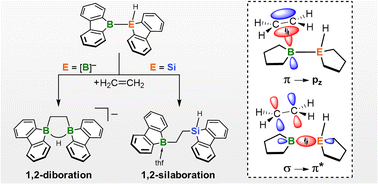Catalyst-free diboration and silaboration of alkenes and alkynes using bis(9-heterofluorenyl)s†
Abstract
Diboration and silaboration reactions are prominent tools to introduce valuable functional groups into organic substrates. To date, most diboranes(4) and silylboranes used for this purpose are electronically and/or kinetically stabilized and require activation by a catalyst. We show here that the tetraaryl (μ-hydrido)diborane(4) anion [3]− and the silyl (hydrido)borate ([4]−)/Me3SiBr system react spontaneously with the archetypal olefin ethylene in the absence of a catalyst. The actual active species in both cases are the valence isoelectronic intermediates [FluB–B(H)Flu]− ([1]−) and FluB–Si(H)Flu (2), which consist of two 9-heterofluorenyl halves that get attached to the 1 and 2 positions of ethylene. At room temperature, [1]− is present in a dynamic equilibrium with its isolable isomer [3]−, while 2 has to be released in situ at low temperatures by H− abstraction from [4]−. Quantum-chemical calculations show qualitatively identical reaction mechanisms for [1]− and 2. Since the reactions start with π coordination of the ethylene molecule to a vacant B(pz) orbital, the high Lewis acidity and low steric hindrance of the 9-borafluorenyl fragments are the keys to success. As the reaction proceeds, back-donation from the B–E bond into the ethylene π* orbital becomes increasingly important (E = B, Si). The scope of the reactions has been extended to tBu(H)C![[double bond, length as m-dash]](https://www.rsc.org/images/entities/char_e001.gif) CH2 and tBuC
CH2 and tBuC![[triple bond, length as m-dash]](https://www.rsc.org/images/entities/char_e002.gif) CH on the one hand and FluB–Si(Cl)Flu as well as FluB–Si(Cl)Ph2 on the other.
CH on the one hand and FluB–Si(Cl)Flu as well as FluB–Si(Cl)Ph2 on the other.

- This article is part of the themed collections: Most popular 2023 inorganic chemistry articles and #MyFirstChemSci 2023


 Please wait while we load your content...
Please wait while we load your content...